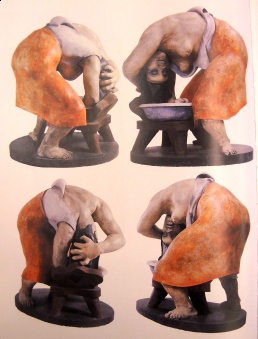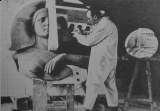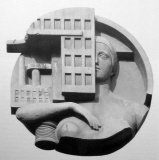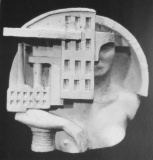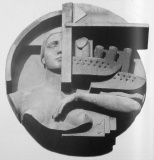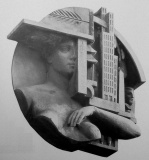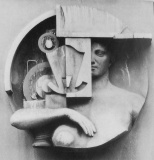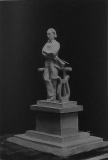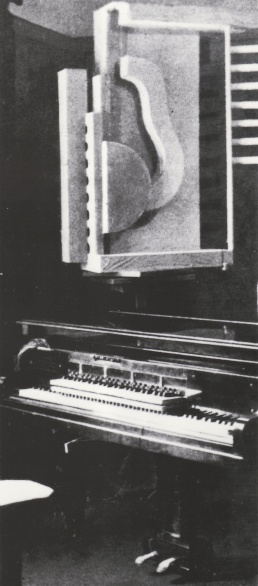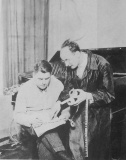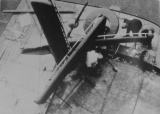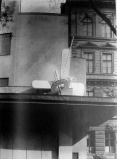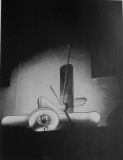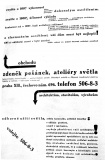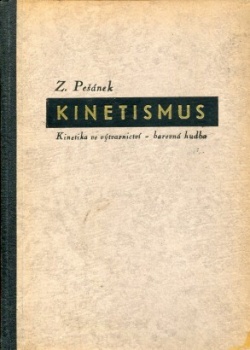Difference between revisions of "Zdeněk Pešánek"
| Line 1: | Line 1: | ||
| − | + | {{Infobox artist | |
| + | |image = Zdenek_Pesanek_and_Jona_Pesankova_1927_in_the_studio_with_Mother_with_a_Child.jpg | ||
| + | |caption = Zdeněk Pešánek and Jöna Pešánková at studio with ''Mother with a Child'', 1927. | ||
| + | |imagesize = 250px | ||
| + | |birth_date = {{birth date|1896|6|12|mf=y}} | ||
| + | |birth_place = Kutná Hora | ||
| + | |death_date = {{Death date and age|1965|11|21|1896|6|12|mf=y}} | ||
| + | |death_place = Poustevny u Rumburka, Czechoslovakia | ||
| + | }} | ||
| + | [[Image:Pesanek_Gavella_Chalabala_Benes_Schulhoff_Flames_Brno_1932.jpg|thumb|258px|Pešánek in 1932.]] | ||
| + | Painter, sculptor, architect, kinetic and light artist. He belongs to the pioneers of abstract geometric art, anticipating the kinetic tendencies in art already in the 1920s. | ||
{{TOC limit|3}} | {{TOC limit|3}} | ||
| − | + | ==Life and work== | |
| + | ===Early years=== | ||
| + | Pešánek's mother came from a family of organ-builders and young Zdeněk spent a lot of time in the organ workshop of his grandfather, Antonín Mölzer (1839–1916)[http://www.varhany.net/zivotopis.php?idv=135302]. Organ-building brings together the domains of music, carving, sculpting as well as the medium of electricity.<ref>{{harvnb|Zemánek|1999|p=7}}</ref> Later he wrote that here he developed his "relation to the mechanism of apparatus".<ref>{{harvnb|Pešánek|1941|p=28}}</ref> | ||
| − | + | ===Studies=== | |
| + | [[Image:Pesanek_Zdenek_1922-23_Washing_After_Work.jpg|thumb|258px|''Toaleta (Po práci)'' [Washing (After Work)], 1922–23. Pešánek's assumed graduation work.]] | ||
| + | Pešánek studied the school of sculpture and masonry in Hořice (Jičín) with Prof. Quido Tomáš Kocián (1914–17), sculpture at the Academy of Fine Arts with Jan Štursa (1918–24), and architecture privately with Jan Kotěra. He came into contact with [[Devětsil]] group in c1922, befriending Jaromír Krejcar, Josef Chochola, Adolf Hoffmeister, Alois Wachsman and others.<ref>{{harvnb|Zemánek|1999|pp=10–11}}</ref> | ||
| − | + | During his studies he was strongly influenced by the contemporary European avant-garde art, expressionism, cubism, and particularly constructivism, and the years 1924–25 saw a breakthrough in his work. He entered [[Devětsil]] association and the Communist Party of Czechoslovakia (both 1924), created a cycle of reliefs for the Post and Telegraphy Office in Brno (1924–25), ''Pomník letcům'' [Aviation Monument] in Prague (1925–26), and began working on his masterwork.<ref>{{harvnb|Zemánek|1999|p=28}}</ref> | |
| − | + | <gallery> | |
| − | + | Pesanek_working_on_the_Transportation_relief_1925.jpg|Working on the ''Transportation'' relief, 1925. | |
| + | Pesanek_Zdenek_Industry_1924-25.jpg|''Industry'', from the relief series for Post and Telegraphy Office, Brno, 1924–25. | ||
| + | Pesanek_Zdenek_Industry_model_1924-25.jpg|''Industry'', model. From the relief series for Post and Telegraphy Office, Brno, 1924–25. | ||
| + | Pesanek_Zdenek_Transportation_1924-25.jpg|''Transporation'', from the relief series for Post and Telegraphy Office, Brno, 1924–25. | ||
| + | Pesanek_Zdenek_Architecture_1924-25.jpg|''Architecture'', from the relief series for Post and Telegraphy Office, Brno, 1924–25. | ||
| + | Pesanek_Zdenek_New_Society_Craddle_1924-25.jpg|''New Society (Craddle)'', from the relief series for Post and Telegraphy Office, Brno, 1924–25. | ||
| + | Pesanek_Zdenek_1925_Smetana_monument_proposal.jpg|Smetana monument proposal, 1925. | ||
| + | Pesanek_Zdenek_1926_Round-shaped_theatre_model.jpg|Round-shaped theatre model, 1926. | ||
| + | </gallery> | ||
| − | + | ===Spectrophone (1924–30)=== | |
| + | [[Image:Pesanek_Zdenek_1925_Spectrophone_with_two_keyboards.jpg|thumb|258px|Spectrophone with two keyboards, 1925.]] | ||
| + | In it, he bridged his pre-school interests with the leading Devětsil's theorist [[Karel Teige]]'s proclaimed idea of "the mechanical kinetic and optophonetic image". Teige's call echoed the then prevailing considerations of time-based art such as the abstract cinema represented by the likes of [[Viktor Eggeling]], although Pešánek took the concept of kinetic art elsewhere. In 1924–26 he constructed a colour piano, the first version of what he called ''Spectrophone''. The instrument projected visual kinetics onto a relief object. Originally he did not mean to include sound element, but in the early 1926 connected its light keyboard to a four-octave music keyboard. His interest in connecting visual kinetics with music did not originate in his own synaesthetic experiences, as was the case of [[Miroslav Ponc]], but in an influence of Fechner's psychophysics. Pešánek assumed it will be possible to normalise the color scale so that he can connect it to the scale of musical tones, ie. to develop a common interface to control both visuals and music. The premiere of the instrument was held on 8 April 1926 privately at his studio, with a performance of Mr. Heřman. Consequently, Pešánek received an invitation from Lessing-Hochschule for a public presentation of his instrument in Berlin, and established contact with the Petrof piano company in Hradec Králové to construct a new model. | ||
| − | + | The second Spectrophone had three color registers (red, green, blue); each key could light up any color; control of the shapes of color fields was introduced; and a round-shaped projection required three meters in diameter. Construction took longer than expected, and the second model, built by Petrof's engineer Alois Zakl based on Pešánek's drawings, had instead its premiere on 13 April 1928 at the Municipal House [Obecní dům] in Prague, with [[Erwin Schulhoff]] playing compositions by [[A.N. Scriabin]]: ''Sonata No. 7'', ''Sonata No. 9'', ''Poem'', ''Nocturnal'', ''Vers la flamme'' and ''Sonata No. 10''. The performance was criticised by Albert Wellek, among others, for its "naive error of inductivism or empiricism, that views the whole as a sum of the parts which can be combined among themselves.. The result is a dance of color grapes (or lampions), whose individual moments give way to often a quite charming purely impressionistic color expression." After his experiences with the three Spectrophones, Pešánek abandoned the idea of a common interface to control both the music and visuals and in line with [[Ludwig Hirschfeld Mack]]'s critique of earlier attempts of [[Louis Bertrand Castel]] admitted that music and visuals should be controlled separately. | |
| − | |||
| − | + | Third model (1928–30) returned to projection onto a relief object. Pešánek presented it at the II. international congress ''Farbe-Ton-Forschung'' at a university in Hamburg in October 1930, also attended by Oskar Fischinger and Hirschfeld Mack. He performed on the Spectrophone along the reproduced music of Richard Wagner's ''Siegfried Idyll'', and delivered lecture entitled ''Bildende Kunst vom Futurismus zur Farben--und Formkinetik''. The reviews were positive, however after a failed attempt to initiate a serial manufacturing of the Spectrophone, encouraged by positive responses from the institutes for the deaf in Prague and Brno (echoing Castel's utopia of helping the deaf to deepen their experience of music), he did not return to the instrument ever since.<ref>{{harvnb|Pešánek|1941|pp=34-44}}</ref><ref>{{harvnb|Zemánek|1999|pp=44-63}}</ref> | |
| − | + | <gallery> | |
| + | Zdenek_Pesanek_and_Erwin_Schulhoff_Spring_1928.jpg|Zdeněk Pešánek and Erwin Schulhoff, spring 1928. | ||
| + | Erwin_Schulhoff_Spectrophone_1928.jpg|Erwin Schulhoff and Spectrophone, 1928. | ||
| + | Pesanek_Zdenek_1928_Spectrophone_projection.jpg|Spectrophone, 1928. | ||
| + | Pesanek_Zdenek_1928_Spectrophone_projection_2.jpg|Spectrophone, 1928. | ||
| + | Pesanek_Zdenek_1928_Spectrophone_projection_3.jpg|Spectrophone, 1928. | ||
| + | Spectrophone_performance_invitation_1928.jpg|Invitation to a Spectrophone performance, 1928. | ||
| + | Spectrophone_performance_invitation_1928_2.jpg|Invitation to a Spectrophone performance, 1928. | ||
| + | </gallery> | ||
| − | + | ==="Edisonka" (1926–30) and collaboration with Prague's Electric Company=== | |
| − | + | [[Image:Pesanek_Zdenek_1930_Edisonka_2.jpg|thumb|258px|Light-kinetic sculpture on the building of Edison transformer station in Prague, 1929–30. Iron, glass, electrical circuits, color electric bulbs, pneumatic piano. Height ca 4 m, length ca 4 m.<ref>{{harvnb|Zemánek|1999|p=134-135}}</ref>]] | |
| + | His light-kinetic sculpture for the Edison transformer station at Jeruzalémská street in Prague remains, along with [[László Moholy-Nagy]]'s ''[[Media:Moholy-Nagy_Laszlo_1930_Light-Space_Modulator.jpg|Light-Space Modulator]]'' (1922–30), the fundamental work of light-kinetic sculpture of the century. The sculpture can be considered an automatised version of (soundless) Spectrophone; it counted 420 colour bulbs (seven rows of white, yellow, green, blue, violet, red, and orange, 15 bulbs each, in each of four parts) and produced pre-programmed light-kinetic "shows" regularly from 7 to 8 PM. "Edisonka" was portrayed by [[Otakar Vávra]] and [[František Pilát]] in the short film ''Světlo proniká tmou'' [The Light Penetrates the Dark] (1931). It is hailed as the world's first public kinetic sculpture. It operated from October 1930 until 1937, and was Pešánek's first realisation in his over a decade-long collaboration with the Electric Company of the City of Prague [Elektrické podniky hlavního města Prahy]. Next to a number of light advertising works, Pešánek organised a lecture and workshop cycle ''O světle'' [About Light] (November 1931–1932) to discuss and introduce artistic considerations into context of street lighting and light advertising.<ref>{{harvnb|Zemánek|1999|pp=xix-xx}}</ref><ref>{{harvnb|Zemánek|1999|pp=120-149}}</ref> | ||
| − | + | <gallery> | |
| + | Pesanek_Zdenek_1930_Edisonka_mounting.jpg|Mounting the sculpture, April 1930.<ref>{{harvnb|Zemánek|1999|p=130}}</ref> | ||
| + | Pesanek_Zdenek_1930_Edisonka_mounting_2.jpg|Mounting the sculpture, April 1930.<ref>{{harvnb|Zemánek|1999|p=130}}</ref> | ||
| + | Pesanek_Zdenek_1929-30_Edisonka_model.jpg|"Edisonka", model, 1929–30.<ref>{{harvnb|Zemánek|1999|p=133}}</ref> | ||
| + | Pesanek_Zdenek_1929-30_Edisonka_model_2.jpg|"Edisonka", model, 1929–30.<ref>{{harvnb|Zemánek|1999|p=133}}</ref> | ||
| + | Pesanek_Zdenek_1930_Edisonka.jpg|Edisonka, 1929–30.<ref>{{harvnb|Zemánek|1999|p=131}}</ref> | ||
| + | Pesanek_Zdenek_1930_Edisonka_3.jpg|"Edisonka", 1929–30.<ref>{{harvnb|Zemánek|1999|p=139}}</ref> | ||
| + | Pesanek_Zdenek_1930_Edisonka_4.jpg|"Edisonka", 1929–30.<ref>{{harvnb|Zemánek|1999|p=140}}</ref> | ||
| + | Pesanek_Zdenek_1930_Edisonka_5.jpg|"Edisonka", 1929–30.<ref>{{harvnb|Zemánek|1999|p=141}}</ref> | ||
| + | Pesanek_Zdenek_early_1930s_Light_studios.jpg|Light studios, early 1930s. | ||
| + | </gallery> | ||
| − | + | <center>{{#widget:Html5media|url=http://monoskop.org/images/5/55/Vavra_Otakar_1931_The_Light_Penetrates_the_Dark_Svetlo_pronika_tmou.webm|width=512|height=384|poster=http://monoskop.org/images/2/27/Vavra-light-dark.jpg}} <br> | |
| − | The | + | ''Světlo proniká tmou'' (The Light Penetrates the Dark, 1931),<br>dir. [[Otakar Vávra]] and [[František Pilát]], 35mm, 4 min, 1931. [http://monoskop.org/images/5/55/Vavra_Otakar_1931_The_Light_Penetrates_the_Dark_Svetlo_pronika_tmou.webm Download (WEBM)] </center> |
| − | ; ''The | + | ===''Sto let elektřiny'' (A Hundred Years of Electricity, 1934–36)=== |
| − | + | A hommage to the researchers and inventors. A series of four kinetic sculptures for Zenger's Edison transformer station in Prague-Klárov (1931–36).<ref>{{harvnb|Zemánek|1999|p=148}}</ref> | |
| + | |||
| + | ===World Exposition in Paris (1937)=== | ||
| + | A series of sculptures shown at the World Exhibition in Paris (1937) was accompanied besides the images also by sound effects; ''Czechoslovak Spa Fountain'' realised at the same exhibition used neon lights. The works were then kept at the premises of their sponsor, Electrical Company of Prague, despite the interest of MOMA New York and Philips in acquiring them [http://www.pre.cz/pre/nase-spolecnost/kultura-pre/svetelny-mag--zdenek-pesanek/mezinarodni-vystava-umeni-a-techniky-v-parizi-v-roce-1937.html]. [http://www.libri.cz/databaze/kdo20/list.php?od=p&start=21&count=20] | ||
| + | |||
| + | ===''Fontána československého lázeňství'' (Czechoslovak Spa Fountain, 1937)=== | ||
| + | The work was displayed at the Czechoslovak pavilion at the World Exposition in Paris in 1937. In the middle of a pool, Pešánek placed one vertical and one horizontal torso made from fiberglass; a long neon bulb protruding from the upper part of each torso curving towards the lower part of the torso in awkward angles accentuated not only the exterior, but simultaneously illuminating the interior. “In addition to neon pipes in two colors, several sections of colored light bulbs ran through the work alternating with white light bulbs. The changing colored light also enriched the play of light through the water beneath the pool.” And the whole work was coordinated to light in rhythmic synchronization with music. Although the public and French press was undoubtedly captivated by such a creation, critics at home considered his work marginal and an “undignified representation” of his native country. Interestingly, Pešánek himself considered this only a study and was faintly disappointed by its completion. He wanted to include an additional set of illuminated jetting columns of water with search lights, but it was never fulfilled for reasons of space. When it was proposed to rebuild this fountain somewhere in Prague, a site was selected; however, the fateful year of 1938 came and the realization of this piece could never be fulfilled. [http://www.art-trans.cz/Reflections.aspx?Show=3] | ||
| + | |||
| + | ===Teaching, UMPRUM=== | ||
| + | Pešánek furthered his educational efforts in establishing collaboration with Prague's Museum of Decorative Arts [Uměleckoprůmyslové museum] in 1936. The museum held his first solo exhibition (1936), and four years later Pešánek installed there the permanent exhibition ''Krásné světlo'' [Beautiful Light] with an extensive section of his light-kinetic works (including spectrophones and reflection games). He also worked with the magazine ''Výtvarná výchova'' and the [[School of Arts and Crafts, Bratislava|School of Arts and Crafts]] in [[Bratislava]]. Its former director, [[Josef Vydra]], edited Pešánek's book ''Kinetismus'' (1941) which was prepared as a practical guide for the light-kinetic art.<ref>{{harvnb|Zemánek|1999|p=xx}}</ref> | ||
| + | |||
| + | ===Later years=== | ||
| + | Despite given several awards, he remained outside of artistic circles of his time, and died in 1965 in seclusion.<ref>{{harvnb|Zemánek|1999|p=xxi}}</ref> | ||
==Exhibitions== | ==Exhibitions== | ||
| − | * World | + | * World Exposition, Paris, 1937. |
| − | * | + | * ''Zdeněk Pešánek 1896/1965'', retrospective, National Gallery, Prague, 1996–97; Guggenheim Museum, New York; Centre Pompidou, Paris. Copies of Pešánek's works were created by [[Federico Díaz]]. [http://www.pre.cz/pre/nase-spolecnost/kultura-pre/svetelny-mag--zdenek-pesanek/vystava-pesankova-dila-v-narodni-galerii-v-roce-1996.html] |
| − | * ''Laterna | + | * ''Laterna magica'', Paris, 2002–03. [http://www.pre.cz/pre/nase-spolecnost/kultura-pre/svetelny-mag--zdenek-pesanek/pesankovo-dilo-do-parize.html] |
| − | * ''The Art of Light'', Karlsruhe. | + | * ''com.bi.nacion: Science meets Art'', Kampa, Prague, 2005. [http://abart-full.artarchiv.cz/vystavy.php?IDvystavy=9418] |
| − | * ''Rytmy + | + | * ''The Art of Light'', ZKM, Karlsruhe, 2006–7. [http://www.pre.cz/pre/nase-spolecnost/kultura-pre/svetelny-mag--zdenek-pesanek/pesanek-opet-do-sveta.html] |
| + | * ''Rytmy + Pohyb + Světlo: Impulsy futurismu v českém umění'', Pilsen and Brno, 2012–2013. [http://abart-full.artarchiv.cz/vystavy.php?IDvystavy=46264] [http://abart-full.artarchiv.cz/vystavy.php?IDvystavy=47694] | ||
| + | |||
| + | ==See also== | ||
| + | * [[Louis Bertrand Castel]] | ||
| + | * [[A.N. Scriabin]] | ||
| + | * [[Czech Republic#Light-music synthesis]] | ||
| + | |||
| + | ==Notes== | ||
| + | {{Reflist|4}} | ||
==Literature== | ==Literature== | ||
| + | {{refbegin}} | ||
[[Image:Pesanek_Zdenek_Kinetismus_Kinetika_ve_vytvarnictvi_barevna_hudba.jpg|thumb|250px|''[http://monoskop.org/log/?p=1235 Kinetismus: Kinetika ve výtvarnictví – barevná hudba]'', 1941.]] | [[Image:Pesanek_Zdenek_Kinetismus_Kinetika_ve_vytvarnictvi_barevna_hudba.jpg|thumb|250px|''[http://monoskop.org/log/?p=1235 Kinetismus: Kinetika ve výtvarnictví – barevná hudba]'', 1941.]] | ||
| − | ; | + | ; Book by Pešánek |
| − | * | + | * {{cite book|ref=harv|last=Pešánek|first=Zdeněk|title=[[Media:Pesanek_Zdenek_Kinetismus_Kinetika_ve_vytvarnictvi_barevna_hudba.jpg|Kinetismus: Kinetika ve výtvarnictví – barevná hudba]]|publisher=Česká grafická Unie|location=Prague|year=1941|pages=144|language=Czech}} With an Introduction by [[František Kalivoda]]. Repr. Prague: Akademie múzických umění, 2013. [http://www.kosmas.cz/knihy/186224/kinetismus/] |
| − | * "Bildende Kunst vom Futurismus zur Farben- und Formkinetik (Mit Vorfuehrung eines Farbe-Ton-Klaviers)", in: Georg Anschutz (ed.), ''Farbe-Ton-Forschungen'', Vol. 1, Hamburg: Meissner, 1931, pp. 193-204. (German) | + | |
| + | ; Articles by Pešánek | ||
| + | * "Chraňme starý ráz Kutné Hory", ''Posázavským krajem'', 12:36, 8.9.1922. (in Czech) | ||
| + | * With Josef Chochola, "Arsinoe", ''Časopis československých architektů'', XXIV, 1925, p 10. (in Czech) | ||
| + | * With Josef Chochola, "Heslo: Černý kruh", ''Časopis československých architektů'', XXIV, 1925, pp 55-59. (in Czech) | ||
| + | * "Pomník padlým letcům v Praze", ''Tribuna'', 17.17.1926, p 3. (in Czech) | ||
| + | * With Josef Chochola, "Petřínská komunikace (původní zpráva)", ''Stavba'', V, 1926-27, p 105. (in Czech) | ||
| + | * "Barevný klavír", in ''Technický slovník naučný'', Vol. 1, ed. Teyssler and Kotyška, Prague, 1927, p 1020-1021. (in Czech) | ||
| + | * "Letectví a výtvarník", ''Letectví'', 7:5, 1927, pp 104-106. (in Czech) | ||
| + | * With J.A. Hollman, "Černý terč", ''Stavba'', VI, 1927-28, p 23. (in Czech) | ||
| + | * "Doslov", in ''Světlo a výtvarné umění v díle Zdeňka a Jöny Pešánkových'', Elektrické podniky hlavního města Prahy, Autumn 1930, pp 25-27. (in Czech) | ||
| + | * "Bildende Kunst vom Futurismus zur Farben- und Formkinetik (Mit Vorfuehrung eines Farbe-Ton-Klaviers)", in: Georg Anschutz (ed.), ''Farbe-Ton-Forschungen'', Vol. 1, Hamburg: Meissner, 1931, pp. 193-204. (in German) | ||
| + | * "Divadlo a světlo", ''Národní divadlo'', 9:28, 26.4.1932, p 7. (in Czech) | ||
| + | * "Ještě k představení 'Švejka'", ''Rudé právo'', 28.7.1933. (in Czech) | ||
| + | * "Světlo ve výtvarném umění", ''Výtvarná výchova'', IV, Vol. 3, 1937-38, pp 6-9. (in Czech) | ||
| + | * "Výtvarný kinetismus", ''Výtvarná výchova'', VI, Vol. 4, 1939-40, pp 18-23. (in Czech) | ||
| + | * "Vyznání architektovo", ''Brázda'', 5:17, 29.4.1942, pp 197-199. (in Czech) | ||
| + | * "Rozprava o historismu v malířství", ''Brázda'', 5:18, 6.5.1942, pp 210-211. (in Czech) | ||
| + | * "Forma výstavního prostoru s ohledem na význam užití světla jako tvárného prvku", ''Architekt SIA'', XXXXII, 1943, pp 53-54. (in Czech) | ||
| + | * "Do 10 let vystavíme náměstí Budovatelů (rozhovor deníku Práce se Z.Pešánkem)", ''Práce'', 26.10.1947. (in Czech) | ||
| + | * With Jiří Kroha, "Náměstí Budovatelů a železnice v severo-východním sektoru Prahy", ''Architektura ČSR'', VI, 1947, pp 171-181. (in Czech) | ||
| + | * With Borek Weiss, "Ervin Schulhoff a barevný klavír", in ''Ervin Schulhoff - vzpomínky, studie a dokumenty'', ed. Věra Stará, Prague: Knižnice hudebních rozhledů, pp 68-78. | ||
| + | * "O světle, světle barevném a kinetickém ve výtvarném umění", ''Kultura'', 33, 1958, pp 5-. | ||
| + | * "Poznámky k estetice světelné kinetiky", ''Výtvarné umění'', 9:5 (21 September 1959), pp 220-227. (in Czech) | ||
| + | * "Světlo jako umění", ''Literární noviny'', 8:40, 3.10.1959, p 9. (in Czech) | ||
| + | * "Světlo, světlo, světlo", ''Československý architekt'', 5:18, 1959, p 3. (in Czech) | ||
| + | * "Kinetismus", ''Acta scaenographica'', 5:1, 1964-65, pp 2-8. (in Czech) | ||
| + | * "Světelně kinetická plastika", ''Acta scaenographica'', 5:2, 1964-65, pp 21-27. (in Czech) | ||
| + | * "Světelně kinetický objekt", ''Acta scaenographica'', 5:5, 1964-65, pp 81-82. (in Czech) | ||
| + | * "Světelná fontána", ''Acta scaenographica'', 5:7, 1964-65, pp 121-122. (in Czech) | ||
| + | * "Die lichtkinetische Plastik", in ''Europa, Europa'', eds. Christoph Brockhaus and Ryszard Stanisławski, 1994, pp 108-109. (in German) | ||
| + | * "Kinetismus", in ''Utopien und Konflikte'', eds. Jiří Ševčík and Peter Weibel, 2007, pp 57-63. (in German) | ||
| + | * "Bemerkungen zur Ästhetik der Lichtkinetik", in ''Utopien und Konflikte'', eds. Jiří Ševčík and Peter Weibel, 2007, pp 173-177. (in German) | ||
| + | |||
| + | ; Books | ||
| + | * {{cite book|ref=harv|title=Světlo a výtvarné umění v díle Zdeňka a Jöny Pešánkových|publisher=Elektrické podniky hlavního města Prahy|location=Prague|year=1930|pages=31|language=Czech}} | ||
| + | ** Adolf Felix, "Umění pohybu", pp 3-7; Antonín Nový, "Světelně-kinetická plastika architekta sochaře Zd. Pešánka na Edisonově transformační stanici u kostela sv. Jindřicha", pp 7-10; Jaroslav Jíra, "O světle v ulicích v cizině a u nás", pp 10-12; Artuš Černík, "Od sochy akademické ke světelně-barevné plastice", pp 13-20; J. Kubín, "Světelná technika a sochařství", pp 21-22; Arnošt Hošek, "Hudba tvarů a barev", pp 22-25; Zdeněk Pešánek, "Doslov", pp 25-27. | ||
| + | * {{cite book|ref=harv|editor-last=Zemánek|editor-first=Jiří|title=Zdeněk Pešánek, 1896-1965|publisher=National Gallery & Gema Art|location=Prague|year=1999|pages=450|language=Czech|isbn=8070351179}} With texts by J. Zemánek, R. Švácha, J. Anděl, M. Juříková, and V. Havránek. [http://www.gemagalerie.cz/cs/publikace/33-zdenek-pesanek] [http://www.gemaart.cz/nakladatelstvi/nase-publikace/zdenek-pesanek-1896-1965-publikace-byla-nominovana-na-cenu-nejkrasnejs] | ||
| − | ; | + | ; Catalogues |
| − | * ''Zdeněk Pešánek: | + | * Petr Hartmann (ed.), ''Světelné plastiky Zdeňka Pešánka'', Prague: Svaz československých výtvarných umělců, 1966, 8 pp. Exhibition catalogue. (in Czech) [http://abart-full.artarchiv.cz/dokumenty.php?IDdokumentu=24284] |
| + | * Petr Hartmann (ed.), ''Zdeněk Pešánek: Světelné plastiky'', Louny: Benedikt Rejt Gallery, 1969, 12 pp. Exhibition catalogue. (in Czech) [http://abart-full.artarchiv.cz/dokumenty.php?IDdokumentu=55838] | ||
| + | * Jiří Zemánek (ed.), ''Zdeněk Pešánek, 1896-1965'', Prague: National Gallery, 1996, 12 pp. ISBN 8070351233. Exhibition catalogue. | ||
| − | ; | + | ; Selected articles |
| − | * Jaromír Fiala, "On My Work with the Pioneer of Kinetic Electric Light Art, Zdeněk Pešánek (1896-1965): A Memoire", ''Leonardo'' 3 (Summer 1980). [http://www.jstor.org/pss/1577814] | + | * Albert Wellek, "Das Farbeklavier", ''Der Auftakt'', 8:4, 25.4.1928, pp 85-89. (in German) |
| + | * František Kalivoda, "Nové podněty pro optofonetickou tvorbu", ''Výtvarná výchova'', 4, Vol. 2, 1937-38, pp 1-45. (in Czech) | ||
| + | * František Kalivoda, "Kinetismus Zdeňka Pešánka", ''Acta scaenographica'', 5:1, 1964-65, pp 1-2. (in Czech) | ||
| + | * Dušan Konečný, "Zdeněk Pešánek a kinetismus v Československu", ''Acta scaenographica'', 6:11, 1965-66, pp 210-212. (in Czech) | ||
| + | * Petr Hartmann, "Kinetická tvorba Zdeňka Pešánka", ''Výtvarné umění'', 16:3, 1966, pp 424-433. (in Czech) | ||
| + | * Dušan Konečný, ''Kinetizmus'', Bratislava: Pallas, 1971, 88 pp. ISBN 9406870. (Slovak) | ||
| + | * Jaromír Fiala, "[http://blog.will-jennings.com/link/Zdenek_Pesanek.pdf On My Work with the Pioneer of Kinetic Electric Light Art, Zdeněk Pešánek (1896-1965): A Memoire]", ''Leonardo'' 3 (Summer 1980), pp 182-185. [http://www.jstor.org/pss/1577814] | ||
| + | * Alice Štefánčíková, "Posel světla Zdeněk Pešánek", ''Revolver Revue'', 21, (November 1992), pp 81-127. (in Czech) [http://www.revolverrevue.cz/zdenek-pesanek] | ||
| + | * Jiří Zemánek, "Kinetismus Zdeňka Pešánka a umění instalace", ''Výtvarné umění'', 4, 1994, pp 102-116. (in Czech) | ||
| + | * Jiří Zemánek, "Ke genezi kinetického umění v českém poetismu - Teigova idea kinografické obrazové básně a Pešánkův barevný klavír", in ''Orbis Fictus - nová média v současném umění'', Prague, 1995, pp 21-52. (in Czech) | ||
| + | * Jiří Zemánek, "Zdeněk Pešánek a kinetika světla v českém umění 30.-70. let", in ''Orbis Fictus - nová média v současném umění'', Prague, 1995, pp 53-66. (in Czech) | ||
| + | * Pavla Pečinková, "Zdeněk Pešánek a László Moholy-Nagy", ''Kritická příloha Revolver Revue 7'', April 1997, pp 28-36. (in Czech) | ||
* Anna Chadová, "Petrof, Schulhoff, Pešánek a barevný klavír", ''Hudební nástroje XXXI'', No. 3, Hradec Králové, 1994, pp 146–149. (in Czech) | * Anna Chadová, "Petrof, Schulhoff, Pešánek a barevný klavír", ''Hudební nástroje XXXI'', No. 3, Hradec Králové, 1994, pp 146–149. (in Czech) | ||
* Jiří Zemánek, "Zdeněk Pešánek a kinetika světla v českém umění 30.–70. let", in: Ludvík Hlaváček, Marta Smolíková (eds.), ''Orbis Fictus'', Prague: Oswald, 1995, pp 53-67. (in Czech) | * Jiří Zemánek, "Zdeněk Pešánek a kinetika světla v českém umění 30.–70. let", in: Ludvík Hlaváček, Marta Smolíková (eds.), ''Orbis Fictus'', Prague: Oswald, 1995, pp 53-67. (in Czech) | ||
| − | * Mahulena Nešlehová, "Impulses of Futurism and Czech Art", in ''International Futurism in Arts and Literature | + | * Mahulena Nešlehová, "[http://books.google.com/books?id=o2t9VviqFtkC&pg=PA141 Impulses of Futurism and Czech Art]", in ''International Futurism in Arts and Literature'', Berlin and New York: Walter de Gruyter, 2000. |
| − | * | + | * Jiří Zemánek, [http://www.fondation-langlois.org/html/e/page.php?NumPage=140 "Zdeněk Pešánek"], in: ''Lanterna magika: New technologies in Czech art of the 20th century'', Prague: KANT, 2002. |
; Theses | ; Theses | ||
| − | * Ondřej Menšík, ''[Zdeněk Pešánek: Kinetismus a světelná kinetika]'', Brno: Masaryk University, 2006, 77 pp. Diploma thesis. (in Czech) | + | * Ondřej Menšík, ''[http://is.muni.cz/th/64842/ff_m/KINETIZMUS.pdf Zdeněk Pešánek: Kinetismus a světelná kinetika]'', Brno: Masaryk University, 2006, 77 pp. Diploma thesis. (in Czech) |
* Jana Matulová, ''[http://is.muni.cz/th/167250/ff_b/Barevna_hudba_final.pdf Barevná hudba]'', Brno: Masaryk University, 2008. Bachelor thesis. (in Czech) | * Jana Matulová, ''[http://is.muni.cz/th/167250/ff_b/Barevna_hudba_final.pdf Barevná hudba]'', Brno: Masaryk University, 2008. Bachelor thesis. (in Czech) | ||
| − | * Kateřina Drajsajtlová, [[Media:Drajsajtlova_Katerina_(Bc)_-_Svetelny_klavir_v_umeleckem_dile_Skrjabina_a_Pesanka_(Czech).pdf|''Světelný klavír v uměleckém díle Alexandera Nikolajeviče Skrjabina a Zdeňka Pešánka'']], | + | * Kateřina Drajsajtlová, [[Media:Drajsajtlova_Katerina_(Bc)_-_Svetelny_klavir_v_umeleckem_dile_Skrjabina_a_Pesanka_(Czech).pdf|''Světelný klavír v uměleckém díle Alexandera Nikolajeviče Skrjabina a Zdeňka Pešánka'']], Bachelor thesis, 2012. (in Czech) [http://monoskop.org/log/?p=4391] |
| + | * Lucie Linhová, ''[[Media:Linhova_Lucie_Zdenek_Pesanek_a_jeho_ucast_na_Mezinarodni_vystave_v_Parizi_v_roce_1937.pdf|Zdeněk Pešánek a jeho účast na Mezinárodní výstavě v Paříži v roce 1937]]'', Prague: Charles University, 2012. Bachelor thesis. (in Czech) [http://is.cuni.cz/webapps/zzp/detail/122927/] | ||
| + | {{refend}} | ||
==External links== | ==External links== | ||
| − | |||
* [http://cs.wikipedia.org/wiki/Zden%C4%9Bk_Pe%C5%A1%C3%A1nek Pešánek at Czech Wikipedia] | * [http://cs.wikipedia.org/wiki/Zden%C4%9Bk_Pe%C5%A1%C3%A1nek Pešánek at Czech Wikipedia] | ||
| + | * [http://abart-full.artarchiv.cz/osoby.php?Fvazba=osobavdokumentech&IDosoby=1055 Pešánek at abArt database] | ||
| + | |||
| + | {{DEFAULTSORT:Pesanek, Zdenek}} | ||
| + | {{featured_article}} | ||
Revision as of 01:45, 22 August 2013
 Zdeněk Pešánek and Jöna Pešánková at studio with Mother with a Child, 1927. | |
| Born |
June 12, 1896 Kutná Hora |
|---|---|
| Died |
November 21, 1965 (aged 69) Poustevny u Rumburka, Czechoslovakia |
Painter, sculptor, architect, kinetic and light artist. He belongs to the pioneers of abstract geometric art, anticipating the kinetic tendencies in art already in the 1920s.
Contents
- 1 Life and work
- 1.1 Early years
- 1.2 Studies
- 1.3 Spectrophone (1924–30)
- 1.4 "Edisonka" (1926–30) and collaboration with Prague's Electric Company
- 1.5 Sto let elektřiny (A Hundred Years of Electricity, 1934–36)
- 1.6 World Exposition in Paris (1937)
- 1.7 Fontána československého lázeňství (Czechoslovak Spa Fountain, 1937)
- 1.8 Teaching, UMPRUM
- 1.9 Later years
- 2 Exhibitions
- 3 See also
- 4 Notes
- 5 Literature
- 6 External links
Life and work
Early years
Pešánek's mother came from a family of organ-builders and young Zdeněk spent a lot of time in the organ workshop of his grandfather, Antonín Mölzer (1839–1916)[1]. Organ-building brings together the domains of music, carving, sculpting as well as the medium of electricity.[1] Later he wrote that here he developed his "relation to the mechanism of apparatus".[2]
Studies
Pešánek studied the school of sculpture and masonry in Hořice (Jičín) with Prof. Quido Tomáš Kocián (1914–17), sculpture at the Academy of Fine Arts with Jan Štursa (1918–24), and architecture privately with Jan Kotěra. He came into contact with Devětsil group in c1922, befriending Jaromír Krejcar, Josef Chochola, Adolf Hoffmeister, Alois Wachsman and others.[3]
During his studies he was strongly influenced by the contemporary European avant-garde art, expressionism, cubism, and particularly constructivism, and the years 1924–25 saw a breakthrough in his work. He entered Devětsil association and the Communist Party of Czechoslovakia (both 1924), created a cycle of reliefs for the Post and Telegraphy Office in Brno (1924–25), Pomník letcům [Aviation Monument] in Prague (1925–26), and began working on his masterwork.[4]
Spectrophone (1924–30)
In it, he bridged his pre-school interests with the leading Devětsil's theorist Karel Teige's proclaimed idea of "the mechanical kinetic and optophonetic image". Teige's call echoed the then prevailing considerations of time-based art such as the abstract cinema represented by the likes of Viktor Eggeling, although Pešánek took the concept of kinetic art elsewhere. In 1924–26 he constructed a colour piano, the first version of what he called Spectrophone. The instrument projected visual kinetics onto a relief object. Originally he did not mean to include sound element, but in the early 1926 connected its light keyboard to a four-octave music keyboard. His interest in connecting visual kinetics with music did not originate in his own synaesthetic experiences, as was the case of Miroslav Ponc, but in an influence of Fechner's psychophysics. Pešánek assumed it will be possible to normalise the color scale so that he can connect it to the scale of musical tones, ie. to develop a common interface to control both visuals and music. The premiere of the instrument was held on 8 April 1926 privately at his studio, with a performance of Mr. Heřman. Consequently, Pešánek received an invitation from Lessing-Hochschule for a public presentation of his instrument in Berlin, and established contact with the Petrof piano company in Hradec Králové to construct a new model.
The second Spectrophone had three color registers (red, green, blue); each key could light up any color; control of the shapes of color fields was introduced; and a round-shaped projection required three meters in diameter. Construction took longer than expected, and the second model, built by Petrof's engineer Alois Zakl based on Pešánek's drawings, had instead its premiere on 13 April 1928 at the Municipal House [Obecní dům] in Prague, with Erwin Schulhoff playing compositions by A.N. Scriabin: Sonata No. 7, Sonata No. 9, Poem, Nocturnal, Vers la flamme and Sonata No. 10. The performance was criticised by Albert Wellek, among others, for its "naive error of inductivism or empiricism, that views the whole as a sum of the parts which can be combined among themselves.. The result is a dance of color grapes (or lampions), whose individual moments give way to often a quite charming purely impressionistic color expression." After his experiences with the three Spectrophones, Pešánek abandoned the idea of a common interface to control both the music and visuals and in line with Ludwig Hirschfeld Mack's critique of earlier attempts of Louis Bertrand Castel admitted that music and visuals should be controlled separately.
Third model (1928–30) returned to projection onto a relief object. Pešánek presented it at the II. international congress Farbe-Ton-Forschung at a university in Hamburg in October 1930, also attended by Oskar Fischinger and Hirschfeld Mack. He performed on the Spectrophone along the reproduced music of Richard Wagner's Siegfried Idyll, and delivered lecture entitled Bildende Kunst vom Futurismus zur Farben--und Formkinetik. The reviews were positive, however after a failed attempt to initiate a serial manufacturing of the Spectrophone, encouraged by positive responses from the institutes for the deaf in Prague and Brno (echoing Castel's utopia of helping the deaf to deepen their experience of music), he did not return to the instrument ever since.[5][6]
"Edisonka" (1926–30) and collaboration with Prague's Electric Company
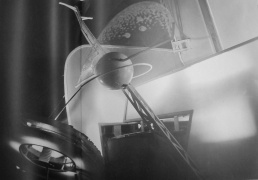
His light-kinetic sculpture for the Edison transformer station at Jeruzalémská street in Prague remains, along with László Moholy-Nagy's Light-Space Modulator (1922–30), the fundamental work of light-kinetic sculpture of the century. The sculpture can be considered an automatised version of (soundless) Spectrophone; it counted 420 colour bulbs (seven rows of white, yellow, green, blue, violet, red, and orange, 15 bulbs each, in each of four parts) and produced pre-programmed light-kinetic "shows" regularly from 7 to 8 PM. "Edisonka" was portrayed by Otakar Vávra and František Pilát in the short film Světlo proniká tmou [The Light Penetrates the Dark] (1931). It is hailed as the world's first public kinetic sculpture. It operated from October 1930 until 1937, and was Pešánek's first realisation in his over a decade-long collaboration with the Electric Company of the City of Prague [Elektrické podniky hlavního města Prahy]. Next to a number of light advertising works, Pešánek organised a lecture and workshop cycle O světle [About Light] (November 1931–1932) to discuss and introduce artistic considerations into context of street lighting and light advertising.[8][9]
Mounting the sculpture, April 1930.[10]
Mounting the sculpture, April 1930.[11]
"Edisonka", model, 1929–30.[12]
"Edisonka", model, 1929–30.[13]
Edisonka, 1929–30.[14]
"Edisonka", 1929–30.[15]
"Edisonka", 1929–30.[16]
"Edisonka", 1929–30.[17]
Světlo proniká tmou (The Light Penetrates the Dark, 1931),
dir. Otakar Vávra and František Pilát, 35mm, 4 min, 1931. Download (WEBM)
Sto let elektřiny (A Hundred Years of Electricity, 1934–36)
A hommage to the researchers and inventors. A series of four kinetic sculptures for Zenger's Edison transformer station in Prague-Klárov (1931–36).[18]
World Exposition in Paris (1937)
A series of sculptures shown at the World Exhibition in Paris (1937) was accompanied besides the images also by sound effects; Czechoslovak Spa Fountain realised at the same exhibition used neon lights. The works were then kept at the premises of their sponsor, Electrical Company of Prague, despite the interest of MOMA New York and Philips in acquiring them [2]. [3]
Fontána československého lázeňství (Czechoslovak Spa Fountain, 1937)
The work was displayed at the Czechoslovak pavilion at the World Exposition in Paris in 1937. In the middle of a pool, Pešánek placed one vertical and one horizontal torso made from fiberglass; a long neon bulb protruding from the upper part of each torso curving towards the lower part of the torso in awkward angles accentuated not only the exterior, but simultaneously illuminating the interior. “In addition to neon pipes in two colors, several sections of colored light bulbs ran through the work alternating with white light bulbs. The changing colored light also enriched the play of light through the water beneath the pool.” And the whole work was coordinated to light in rhythmic synchronization with music. Although the public and French press was undoubtedly captivated by such a creation, critics at home considered his work marginal and an “undignified representation” of his native country. Interestingly, Pešánek himself considered this only a study and was faintly disappointed by its completion. He wanted to include an additional set of illuminated jetting columns of water with search lights, but it was never fulfilled for reasons of space. When it was proposed to rebuild this fountain somewhere in Prague, a site was selected; however, the fateful year of 1938 came and the realization of this piece could never be fulfilled. [4]
Teaching, UMPRUM
Pešánek furthered his educational efforts in establishing collaboration with Prague's Museum of Decorative Arts [Uměleckoprůmyslové museum] in 1936. The museum held his first solo exhibition (1936), and four years later Pešánek installed there the permanent exhibition Krásné světlo [Beautiful Light] with an extensive section of his light-kinetic works (including spectrophones and reflection games). He also worked with the magazine Výtvarná výchova and the School of Arts and Crafts in Bratislava. Its former director, Josef Vydra, edited Pešánek's book Kinetismus (1941) which was prepared as a practical guide for the light-kinetic art.[19]
Later years
Despite given several awards, he remained outside of artistic circles of his time, and died in 1965 in seclusion.[20]
Exhibitions
- World Exposition, Paris, 1937.
- Zdeněk Pešánek 1896/1965, retrospective, National Gallery, Prague, 1996–97; Guggenheim Museum, New York; Centre Pompidou, Paris. Copies of Pešánek's works were created by Federico Díaz. [5]
- Laterna magica, Paris, 2002–03. [6]
- com.bi.nacion: Science meets Art, Kampa, Prague, 2005. [7]
- The Art of Light, ZKM, Karlsruhe, 2006–7. [8]
- Rytmy + Pohyb + Světlo: Impulsy futurismu v českém umění, Pilsen and Brno, 2012–2013. [9] [10]
See also
Notes
- ↑ Zemánek 1999, p. 7
- ↑ Pešánek 1941, p. 28
- ↑ Zemánek 1999, pp. 10–11
- ↑ Zemánek 1999, p. 28
- ↑ Pešánek 1941, pp. 34-44
- ↑ Zemánek 1999, pp. 44-63
- ↑ Zemánek 1999, p. 134-135
- ↑ Zemánek 1999, pp. xix-xx
- ↑ Zemánek 1999, pp. 120-149
- ↑ Zemánek 1999, p. 130
- ↑ Zemánek 1999, p. 130
- ↑ Zemánek 1999, p. 133
- ↑ Zemánek 1999, p. 133
- ↑ Zemánek 1999, p. 131
- ↑ Zemánek 1999, p. 139
- ↑ Zemánek 1999, p. 140
- ↑ Zemánek 1999, p. 141
- ↑ Zemánek 1999, p. 148
- ↑ Zemánek 1999, p. xx
- ↑ Zemánek 1999, p. xxi
Literature
- Book by Pešánek
- Pešánek, Zdeněk (1941). Kinetismus: Kinetika ve výtvarnictví – barevná hudba. Prague: Česká grafická Unie. pp. 144 (Czech). With an Introduction by František Kalivoda. Repr. Prague: Akademie múzických umění, 2013. [11]
- Articles by Pešánek
- "Chraňme starý ráz Kutné Hory", Posázavským krajem, 12:36, 8.9.1922. (in Czech)
- With Josef Chochola, "Arsinoe", Časopis československých architektů, XXIV, 1925, p 10. (in Czech)
- With Josef Chochola, "Heslo: Černý kruh", Časopis československých architektů, XXIV, 1925, pp 55-59. (in Czech)
- "Pomník padlým letcům v Praze", Tribuna, 17.17.1926, p 3. (in Czech)
- With Josef Chochola, "Petřínská komunikace (původní zpráva)", Stavba, V, 1926-27, p 105. (in Czech)
- "Barevný klavír", in Technický slovník naučný, Vol. 1, ed. Teyssler and Kotyška, Prague, 1927, p 1020-1021. (in Czech)
- "Letectví a výtvarník", Letectví, 7:5, 1927, pp 104-106. (in Czech)
- With J.A. Hollman, "Černý terč", Stavba, VI, 1927-28, p 23. (in Czech)
- "Doslov", in Světlo a výtvarné umění v díle Zdeňka a Jöny Pešánkových, Elektrické podniky hlavního města Prahy, Autumn 1930, pp 25-27. (in Czech)
- "Bildende Kunst vom Futurismus zur Farben- und Formkinetik (Mit Vorfuehrung eines Farbe-Ton-Klaviers)", in: Georg Anschutz (ed.), Farbe-Ton-Forschungen, Vol. 1, Hamburg: Meissner, 1931, pp. 193-204. (in German)
- "Divadlo a světlo", Národní divadlo, 9:28, 26.4.1932, p 7. (in Czech)
- "Ještě k představení 'Švejka'", Rudé právo, 28.7.1933. (in Czech)
- "Světlo ve výtvarném umění", Výtvarná výchova, IV, Vol. 3, 1937-38, pp 6-9. (in Czech)
- "Výtvarný kinetismus", Výtvarná výchova, VI, Vol. 4, 1939-40, pp 18-23. (in Czech)
- "Vyznání architektovo", Brázda, 5:17, 29.4.1942, pp 197-199. (in Czech)
- "Rozprava o historismu v malířství", Brázda, 5:18, 6.5.1942, pp 210-211. (in Czech)
- "Forma výstavního prostoru s ohledem na význam užití světla jako tvárného prvku", Architekt SIA, XXXXII, 1943, pp 53-54. (in Czech)
- "Do 10 let vystavíme náměstí Budovatelů (rozhovor deníku Práce se Z.Pešánkem)", Práce, 26.10.1947. (in Czech)
- With Jiří Kroha, "Náměstí Budovatelů a železnice v severo-východním sektoru Prahy", Architektura ČSR, VI, 1947, pp 171-181. (in Czech)
- With Borek Weiss, "Ervin Schulhoff a barevný klavír", in Ervin Schulhoff - vzpomínky, studie a dokumenty, ed. Věra Stará, Prague: Knižnice hudebních rozhledů, pp 68-78.
- "O světle, světle barevném a kinetickém ve výtvarném umění", Kultura, 33, 1958, pp 5-.
- "Poznámky k estetice světelné kinetiky", Výtvarné umění, 9:5 (21 September 1959), pp 220-227. (in Czech)
- "Světlo jako umění", Literární noviny, 8:40, 3.10.1959, p 9. (in Czech)
- "Světlo, světlo, světlo", Československý architekt, 5:18, 1959, p 3. (in Czech)
- "Kinetismus", Acta scaenographica, 5:1, 1964-65, pp 2-8. (in Czech)
- "Světelně kinetická plastika", Acta scaenographica, 5:2, 1964-65, pp 21-27. (in Czech)
- "Světelně kinetický objekt", Acta scaenographica, 5:5, 1964-65, pp 81-82. (in Czech)
- "Světelná fontána", Acta scaenographica, 5:7, 1964-65, pp 121-122. (in Czech)
- "Die lichtkinetische Plastik", in Europa, Europa, eds. Christoph Brockhaus and Ryszard Stanisławski, 1994, pp 108-109. (in German)
- "Kinetismus", in Utopien und Konflikte, eds. Jiří Ševčík and Peter Weibel, 2007, pp 57-63. (in German)
- "Bemerkungen zur Ästhetik der Lichtkinetik", in Utopien und Konflikte, eds. Jiří Ševčík and Peter Weibel, 2007, pp 173-177. (in German)
- Books
- Světlo a výtvarné umění v díle Zdeňka a Jöny Pešánkových. Prague: Elektrické podniky hlavního města Prahy. 1930. pp. 31 (Czech).
- Adolf Felix, "Umění pohybu", pp 3-7; Antonín Nový, "Světelně-kinetická plastika architekta sochaře Zd. Pešánka na Edisonově transformační stanici u kostela sv. Jindřicha", pp 7-10; Jaroslav Jíra, "O světle v ulicích v cizině a u nás", pp 10-12; Artuš Černík, "Od sochy akademické ke světelně-barevné plastice", pp 13-20; J. Kubín, "Světelná technika a sochařství", pp 21-22; Arnošt Hošek, "Hudba tvarů a barev", pp 22-25; Zdeněk Pešánek, "Doslov", pp 25-27.
- Zemánek, Jiří, ed. (1999). Zdeněk Pešánek, 1896-1965. Prague: National Gallery & Gema Art. pp. 450. ISBN 8070351179 (Czech). With texts by J. Zemánek, R. Švácha, J. Anděl, M. Juříková, and V. Havránek. [12] [13]
- Catalogues
- Petr Hartmann (ed.), Světelné plastiky Zdeňka Pešánka, Prague: Svaz československých výtvarných umělců, 1966, 8 pp. Exhibition catalogue. (in Czech) [14]
- Petr Hartmann (ed.), Zdeněk Pešánek: Světelné plastiky, Louny: Benedikt Rejt Gallery, 1969, 12 pp. Exhibition catalogue. (in Czech) [15]
- Jiří Zemánek (ed.), Zdeněk Pešánek, 1896-1965, Prague: National Gallery, 1996, 12 pp. ISBN 8070351233. Exhibition catalogue.
- Selected articles
- Albert Wellek, "Das Farbeklavier", Der Auftakt, 8:4, 25.4.1928, pp 85-89. (in German)
- František Kalivoda, "Nové podněty pro optofonetickou tvorbu", Výtvarná výchova, 4, Vol. 2, 1937-38, pp 1-45. (in Czech)
- František Kalivoda, "Kinetismus Zdeňka Pešánka", Acta scaenographica, 5:1, 1964-65, pp 1-2. (in Czech)
- Dušan Konečný, "Zdeněk Pešánek a kinetismus v Československu", Acta scaenographica, 6:11, 1965-66, pp 210-212. (in Czech)
- Petr Hartmann, "Kinetická tvorba Zdeňka Pešánka", Výtvarné umění, 16:3, 1966, pp 424-433. (in Czech)
- Dušan Konečný, Kinetizmus, Bratislava: Pallas, 1971, 88 pp. ISBN 9406870. (Slovak)
- Jaromír Fiala, "On My Work with the Pioneer of Kinetic Electric Light Art, Zdeněk Pešánek (1896-1965): A Memoire", Leonardo 3 (Summer 1980), pp 182-185. [16]
- Alice Štefánčíková, "Posel světla Zdeněk Pešánek", Revolver Revue, 21, (November 1992), pp 81-127. (in Czech) [17]
- Jiří Zemánek, "Kinetismus Zdeňka Pešánka a umění instalace", Výtvarné umění, 4, 1994, pp 102-116. (in Czech)
- Jiří Zemánek, "Ke genezi kinetického umění v českém poetismu - Teigova idea kinografické obrazové básně a Pešánkův barevný klavír", in Orbis Fictus - nová média v současném umění, Prague, 1995, pp 21-52. (in Czech)
- Jiří Zemánek, "Zdeněk Pešánek a kinetika světla v českém umění 30.-70. let", in Orbis Fictus - nová média v současném umění, Prague, 1995, pp 53-66. (in Czech)
- Pavla Pečinková, "Zdeněk Pešánek a László Moholy-Nagy", Kritická příloha Revolver Revue 7, April 1997, pp 28-36. (in Czech)
- Anna Chadová, "Petrof, Schulhoff, Pešánek a barevný klavír", Hudební nástroje XXXI, No. 3, Hradec Králové, 1994, pp 146–149. (in Czech)
- Jiří Zemánek, "Zdeněk Pešánek a kinetika světla v českém umění 30.–70. let", in: Ludvík Hlaváček, Marta Smolíková (eds.), Orbis Fictus, Prague: Oswald, 1995, pp 53-67. (in Czech)
- Mahulena Nešlehová, "Impulses of Futurism and Czech Art", in International Futurism in Arts and Literature, Berlin and New York: Walter de Gruyter, 2000.
- Jiří Zemánek, "Zdeněk Pešánek", in: Lanterna magika: New technologies in Czech art of the 20th century, Prague: KANT, 2002.
- Theses
- Ondřej Menšík, Zdeněk Pešánek: Kinetismus a světelná kinetika, Brno: Masaryk University, 2006, 77 pp. Diploma thesis. (in Czech)
- Jana Matulová, Barevná hudba, Brno: Masaryk University, 2008. Bachelor thesis. (in Czech)
- Kateřina Drajsajtlová, Světelný klavír v uměleckém díle Alexandera Nikolajeviče Skrjabina a Zdeňka Pešánka, Bachelor thesis, 2012. (in Czech) [18]
- Lucie Linhová, Zdeněk Pešánek a jeho účast na Mezinárodní výstavě v Paříži v roce 1937, Prague: Charles University, 2012. Bachelor thesis. (in Czech) [19]
External links

